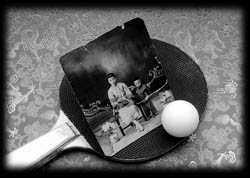
|
|
Angel Island history
Former Angel
How you can
|
Artistry of the LensWith subjects ranging from Chinese immigrants to society's fixation on violence, the Beaumont Art League's Photography Show reveals the world as seen through the eye of the camera
The Beaumont Enterprise, copyright June 26, 1998
BEAUMONT, Tx -- Lydia Lum's still-life photographs are etched in black-and- white, recalling a time in America when people thought that way, too. There were Americans -- foreigners -- and the United States at the turn of the century had begun to implement policies that restricted the flow of immigration to the great melting pot. Immigrants from eastern Europe had to pass through Ellis Island in New York Harbor while Asians went through a little-known depot called Angel Island in San Francisco Bay. Unlike Ellis Island, these immigrants were not only stopped and interrogated but detained. Sometimes for weeks, even months. "You don't think about it much but it's true," said Lum, 30, a fourth- generation Asian-American. "Someone had to really struggle for me to be born here." Lum's six-part series of photographs is one of the more than 100 photo and video entries on view on the Beaumont Art League's Photography Show, which opens Saturday with a reception 7 p.m. to 9 p.m. The winner's work and other photographs will stay up through July 25 at the league's Brown and Scurlock galleries, located at 2675 Gulf St., in Fair Park. Photographer Gregg Mankiller, director and co-founder of Photo Americas, an arts and education nonprofit organization based in Tulsa, Okla., will judge the show, now in its 10th year. Cash awards will be given for first, second and third place. At least half of the work is for sale. This year's show attracted a diversity of photographic work, by amateurs and professionals, ranging from photos of children and landscapes to expressionist creations and a large-scale videographic set-up. Entries came in from all over the area, including Houston, Mid-County, Orange and Lumberton. The show provides a venue for photogaphers to show their work and have it judged by a professional, said league executive director Arianna Barrios. "Many of the exhibits in the area are fine art-oriented, almost exclusively painting," Barrios said. "We're finding with this show we're getting a real cross-section of people from different walks of life, different experiences." Show chairwoman Colleen Burns said this type of show is critical because artists need a place to exhibit their work. "You need that criticism, that feedback," said Burns, a painter. "That's the way you grow as an artist." Lamar graduate Kenneth Wiatrek's video entry, "Visual (Recorded Variety) #0001" is his attempt to do just that. His entry is a video exploration of how violence affects our daily lives and perpetuates itself through mass media, he said. On one wall of Scurlock Gallery, Wiatrek has set up a lightbox with the image of a television news set projected on it. "The God," he says. In front of it are three computer monitors -- the father, son and the holy spirit. The monitors flash quick clips of violence from the movies, television, the Internet and photographs he shot. The result is a barrage of images that assault the viewer without regard to a cohesive narrative. "I didn't want a story here because I don't want people who view this to be comfortable," said Wiatrek, who has been working on the project for about three years. "Violence isn't comfortable. It's a problem and a plague that we let the media perpetuate." He said the project is a reaction to his generation's fascination with "violent entertainment" such as movies like "Pulp Fiction" and "Natural Born Killers." "The media uses images to communicate and sway thoughts," said Wiatrek, who will attend the University of Houston College of Humanities and Fine Arts this fall. "I want people to walk away from this thinking about where we are now -- and where we're going." America's past -- and present -- are addressed in a very different way in the six-part series of photographs by Lum, a Houston writer and photographer. Her interest in her own Asian heritage -- and a commission from some Houston community groups this past February -- pushed Lum to seek out some of the Chinese Houstonians who had passed through Angel Island, the West Coast immigration station. Lum said some Chinese were deported, but those who were allowed to remain headed to all parts of the United States. Some made their way to southern U.S. cities such as Houston. "These people were looking for a better life. For themselves, their children," Lum said. According to her commission, she had to complete the project in six weeks, and she did. She worked six consecutive weekends and in the evenings after her work as a staff writer at the Houston Chronicle. In the end, she produced a total of 16 photos, both still lifes and portraits. It is still a work-in-progress, she said. The photographs, accompanied by a key, show images that are at once sad and moving, somber and touching. One photograph, titled "Surviving Detention," a knife, matches and feathers from a pigeon rest on a traditional Chinese embroidered cloth. In the text that accompanies it, Lester Tom Lee, who immigrated in 1935, talks about being hungry and small enough to grab the necks of birds outside the fence of the camp. With matches and a knife, "we barbecued birds. It was the only tasty thing we could get," he said. Some of her photos even touch upon the somewhat happy memories of the children imprisoned at the depot. "To a child, it's just one big adventure. Any 9-year-old is going to have a pretty good time," she said. "But what's interesting is that after all of these years, these people don't think of it with pain. They still remember as children. Memory is a strange, beautiful thing." |
